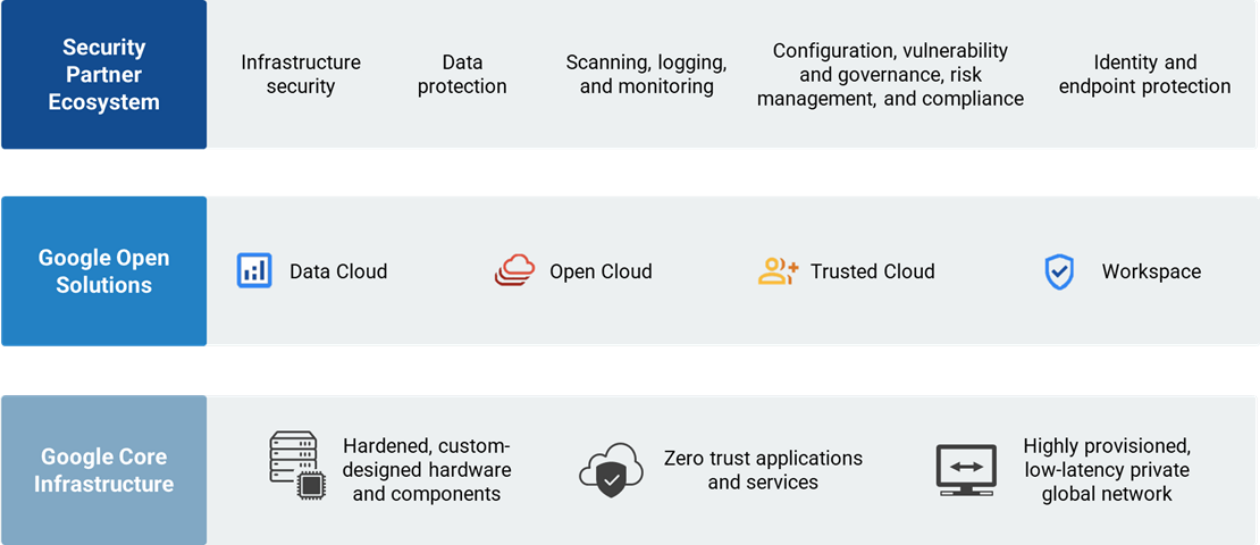
TECHNICAL VALIDATION
How to Deliver Successful AI Projects by Reducing Risk and Boosting Performance
Google Cloud Security Ecosystem—Wiz
How to Deliver Successful AI Projects by Reducing Risk and Boosting Performance
Leveraging the Google Platform to Accelerate the
Delivery of Differentiated Security Offerings
By Tony Palmer, Practice Director and Principal Analyst, Validation Services
Enterprise Strategy Group
December 2023
Introduction
Background
Figure 1. Cloud-first Policy for New Applications on the Rise

The Google Cloud Security Ecosystem
Google Cloud is designed, built, and operated with security as a primary design principle to help protect its customers against threats in their environments. Google layers on security controls to enable organizations to meet their own policy, regulatory, and business objectives. Customers can leverage elements of Google’s compliance framework in their own compliance programs.
Google Cloud secures more than three billion users globally. To accomplish that, Google’s cloud infrastructure can’t rely on any single technology to make it secure. Google’s stack builds security through progressive layers designed to deliver true defense in depth, and at scale.
Figure 2. Google Cloud Security Ecosystem Overview

Source: Enterprise Strategy Group, a division of TechTarget, Inc.
Google Workspace

Enterprise Strategy Group Technical Validation
Wiz for Google Cloud
Figure 3. Wiz Security Graph Visualization

Source: Wiz and Enterprise Strategy Group, a division of TechTarget, Inc.
Figure 4. Wiz Compliance Heatmap

Source: Wiz and Enterprise Strategy Group, a division of TechTarget, Inc.

Why This Matters
The vast majority of modern organizations are leveraging the cloud to improve productivity, drive innovation, and gain or maintain competitive advantage.5 Modernizing applications and services with cloud technologies can outpace organizations’ ability to secure their environments. Organizations need to visualize and understand the relationships between the layers of configurations, networks, and identities that make up their environments.
Organizations typically adopt numerous point-based security tools to try to gain control in their effort to close visibility gaps, but this makes a unified, coherent view challenging, to say the least. Google Cloud provides Wiz with the agility and seamless scalability needed to provide rapid visibility into critical risks, including the context and actionable insights needed for immediate remediation for new customers within minutes of deployment.
Building its solutions using Google Kubernetes Engine on Google Cloud and leveraging Google Cloud-managed solutions and native security services means that Wiz can reduce the time and resources expended on infrastructure management and concentrate on developing new solutions that meet their customers’ specific needs.
Conclusion
This Enterprise Strategy Group Technical Validation was commissioned by Google and is distributed under license from TechTarget, Inc.
©TechTarget, Inc. or its subsidiaries. All rights reserved. TechTarget, and the TechTarget logo, are trademarks or registered trademarks of TechTarget, Inc. and are registered in jurisdictions worldwide. Other product and service names and logos, including for BrightTALK, Xtelligent, and the Enterprise Strategy Group might be trademarks of TechTarget or its subsidiaries. All other trademarks, logos and brand names are the property of their respective owners.
Information contained in this publication has been obtained by sources TechTarget considers to be reliable but is not warranted by TechTarget. This publication may contain opinions of TechTarget, which are subject to change. This publication may include forecasts, projections, and other predictive statements that represent TechTarget’s assumptions and expectations in light of currently available information. These forecasts are based on industry trends and involve variables and uncertainties. Consequently, TechTarget makes no warranty as to the accuracy of specific forecasts, projections or predictive statements contained herein.
Any reproduction or redistribution of this publication, in whole or in part, whether in hard-copy format, electronically, or otherwise to persons not authorized to receive it, without the express consent of TechTarget, is in violation of U.S. copyright law and will be subject to an action for civil damages and, if applicable, criminal prosecution. Should you have any questions, please contact Client Relations at cr@esg-global.com.
About Enterprise Strategy Group
TechTarget’s Enterprise Strategy Group provides focused and actionable market intelligence, demand-side research, analyst advisory services, GTM strategy guidance, solution validations, and custom content supporting enterprise technology buying and selling.
